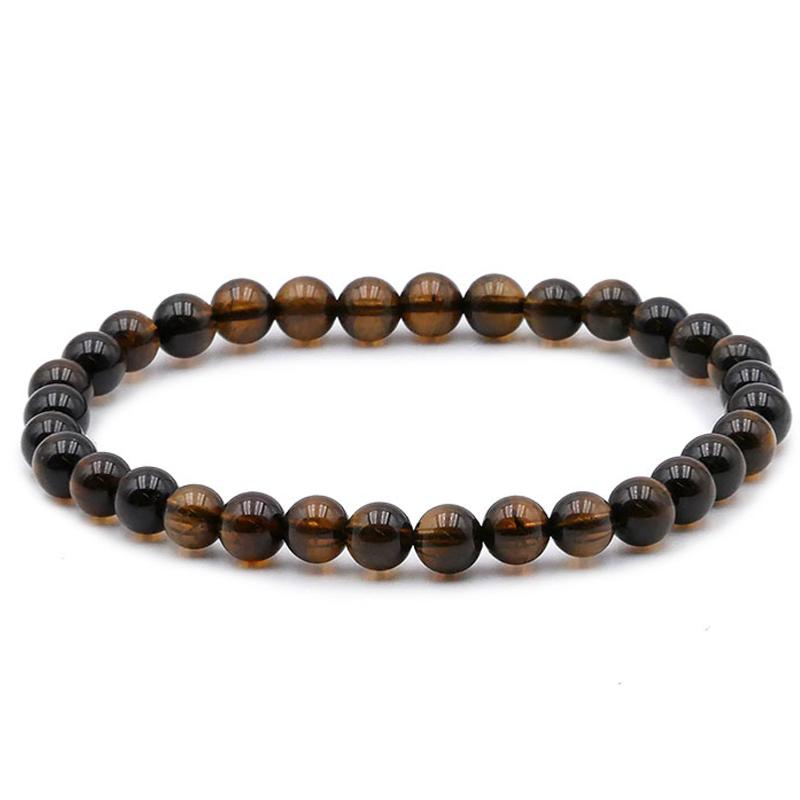Brown tourmaline bracelet Brazil A+ (dravite) balls 5-6mm
BRA-TOUR-29
- Regular price
-
49,90 € - Regular price
-
49,90 € - Sale price
-
49,90 €
Couldn't load pickup availability
Learn more
BRA-TOUR-29
Origin: Brazil
Grade: A+
Very beautiful elastic bracelet composed of 5-6mm brown tourmaline balls (dravite)
Patterns and colors may vary from one bracelet to another
The name tourmaline comes from “turmali” or “turamali” which is in fact a Sinhalese name given to this fabulous stone from Sri Lanka by Dutch explorers at the beginning of the 18th century.
In Sri Lanka, a legend says that tourmaline comes from the sky and during its descent to earth, it crossed a rainbow which transmitted its color variations. Which explains the origin of its name meaning “the stone of a thousand colors”.
In fact, tourmaline has been known for millennia. In the 3rd century BC, we found traces of this stone. In Greece, it was Alexander the Great (356-323 BC) who brought this stone back from these expeditions. However, tourmaline, due to its many colors, has very often been confused with other minerals.
Thus, there are very few legends or myths attached to this stone due to its late identification. However, some tourmalines have piezoelectric properties, meaning they have an electric charge, negative at one pole and positive at the other pole. Tourmaline attracts particles to itself.
When the philosopher Theophrastus (-322 to -288) describes a stone having the ability to attract pieces of straw or pieces of wood to itself, we understand that he is talking about tourmaline. Later in the 18th century, Dutch explorers used tourmaline to clean their pipes because the stone attracted ashes.
For the record, in the 16th century, a Spanish conquistador discovered a green tourmaline in Brazil, which he identified as an emerald. This discovery caused a rush in the Brazilian regions in search of these famous emeralds. The error was corrected in the 19th century and the emeralds were transformed into tourmalines.
Many times confused with precious stones, tourmalines are therefore found in many jewelry, and even in the British crown. We can also mention the Timur Ruby, a 352-carat jewel that was thought to be a ruby until 1851, or the 170-carat Black Prince ruby which is actually a tourmaline.
Tourmaline is causing more and more enthusiasm among connoisseurs and collectors. Thus, the Empress of China Cixi (1861-1908) loved this stone so much that she began to collect it. She asked for sculptures, brooches, watch straps, rings, etc. to be made for her. Today it rests on a cushion of tourmalines.
Tourmaline comes in various shades. They can also be two-tone or multi-colored. There is a wide variety of tourmalines, in different colors, from opaque to transparent, with striated or hexagonal structures. It has a rhombohedral crystal system. It is a magmatic and metamorphic rock which may come from hydrothermal deposits.
Thus, there are several kinds of tourmalines with varied compositions such as magnesium silicates, sodium silicates, iron, clay, fluorides and borosilicate. Tourmalines are actually an entire family of stones, which have the same internal structure, but differ in chemical composition and therefore in color and appearance.
The main deposits are located in Brazil, Afghanistan, Australia, Brazil, Russia, Thailand, Burma, Madagascar, India, and the United States.
Brown tourmaline or dravite is a variety of brown or mahogany colored tourmaline, sometimes so dark that it is confused with black tourmaline. It is a mineral of the cyclosilicate family, hydroxylated with sodium, aluminum and magnesium.
In addition to the elements in its formula, brown tourmaline may contain impurities of iron, manganese, titanium, calcium, chromium, vanadium, potassium and fluorine. It is especially appreciated for its high magnesium content.
This mineral is found mainly in crystalline limestone rocks or in dolomites, or even in mafic igneous rocks (for the record: mafic: refers to a rock or mineral rich in iron and magnesium).
Discovered in 1883 in Slovenia, brown tourmaline also goes by the name dravite because of the river where it was found in abundance. This river is called Drava and is located in Slovenia and Austria.
Brown tourmaline stands out with its transparent appearance. It has a rhombohedral crystal system and has a hardness of 7 to 7.5 on the Mohs scale. For comparison, diamond has the highest hardness, 10 on this same scale.
The main deposits are located in Brazil, etc.
Brown tourmaline helps overcome life's difficulties and gives the courage to accept the unthinkable. It allows you to make peace with your past and identify the origin of certain blockages often linked to childhood. Emotional wounds from past experiences are transformed into gentle healing.
An anchor stone, brown tourmaline gives a sense of responsibility and a full awareness of reality. It offers its wearer the opportunity to fully enjoy life and the present moment, without worrying about the past or the future. It inspires a more stable, ordered and structured life.
This stone encourages sociability: the wearer of a brown tourmaline opens up to others more easily. He shows more empathy, compassion and understanding. He learns to trust others and to thrive socially. This stone is recommended for people suffering from social adaptation problems.
Furthermore, brown tourmaline is known to stimulate creativity. It is perfect for artists or those who love to create. It is said to free the mind and imagination. It also increases memorization skills.
It is also a stone of protection against negative energies such as anger, resentment and hatred. It keeps harmful people away from the environment of the wearer of brown tourmaline.


Brown tourmaline bracelet Brazil A+ (dravite) balls 5-6mm
- Regular price
-
49,90 € - Regular price
-
49,90 € - Sale price
-
49,90 €
-
100% SECURE PAYMENT
Paypal, credit card, check, transfer
-
FREE DELIVERY
from 40€ purchase
-
SATISFIED OR REFUNDED
14 days to change your mind
-
CUSTOMER SERVICE AVAILABLE
contact@laboiteacailloux.com
to receive all our offers, good deals and new products from La Boite à Cailloux


